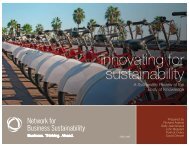embedding sustainability in organizational culture - Network for ...
embedding sustainability in organizational culture - Network for ...
embedding sustainability in organizational culture - Network for ...
You also want an ePaper? Increase the reach of your titles
YUMPU automatically turns print PDFs into web optimized ePapers that Google loves.
appeNdIx Chapter 1: a: Introduction Methodology<br />
59<br />
In conduct<strong>in</strong>g our review, we found <strong>in</strong>stances where practitioner knowledge is<br />
currently lead<strong>in</strong>g theory. We also found numerous <strong>in</strong>stances where academics<br />
proposed practices that were not directly tested <strong>in</strong> their own work. Rather than<br />
limit our exam<strong>in</strong>ation to empirically tested practices, we identified all the relevant<br />
practices regardless of the level of empirical support and documented whether<br />
each <strong>in</strong>stance had been proposed, empirically tested and supported or empirically<br />
tested and unsupported. This <strong>in</strong><strong>for</strong>mation was <strong>in</strong>cluded <strong>in</strong> our report<strong>in</strong>g <strong>in</strong> order to<br />
summarize what we know, what we th<strong>in</strong>k we know and what we don’t know based<br />
on the best available evidence.<br />
In the sections below, we document each phase of our research process <strong>in</strong> more<br />
detail.<br />
selection of research question and keyWords<br />
As recommended by Br<strong>in</strong>er and Denyer (2010), the research questions <strong>for</strong> this<br />
review were developed through a discussion with the lead researcher and an<br />
advisory council composed of NBS Leadership Council members, an academic<br />
advisor with experience <strong>in</strong> the area of systematic reviews, and the manag<strong>in</strong>g<br />
director of the NBS. Given the broad nature of both the concepts of <strong>susta<strong>in</strong>ability</strong><br />
and <strong>organizational</strong> <strong>culture</strong>, we first needed to ask the questions: what is meant by<br />
<strong>susta<strong>in</strong>ability</strong>; what is meant by <strong>embedd<strong>in</strong>g</strong>; and what is meant by <strong>culture</strong>? After<br />
thoroughly discuss<strong>in</strong>g these constructs, we sought a set of guid<strong>in</strong>g questions that<br />
would bound the study <strong>in</strong> a way that was conducive to mak<strong>in</strong>g decisions about what<br />
sources to <strong>in</strong>clude and exclude from the study. We arrived at the follow<strong>in</strong>g two<br />
research questions:<br />
• What do we know about how organizations can embed <strong>susta<strong>in</strong>ability</strong><br />
<strong>in</strong>to their <strong>organizational</strong> <strong>culture</strong>?<br />
• What can potentially be learned from analogous cultural<br />
<strong>in</strong>terventions <strong>in</strong> the areas of <strong>in</strong>novation, safety, compliance, total<br />
quality management, and high reliability organizations?<br />
Based on these questions, the research team developed a strategy <strong>for</strong> the<br />
identification of studies, which <strong>in</strong>cluded generat<strong>in</strong>g a list of keywords <strong>for</strong> the<br />
search, outl<strong>in</strong><strong>in</strong>g the potential data sources and determ<strong>in</strong><strong>in</strong>g a set of criteria <strong>for</strong><br />
the <strong>in</strong>clusion and exclusion of studies. This protocol was reviewed by the advisory<br />
council <strong>for</strong> the project. Our orig<strong>in</strong>al keywords were as follows:<br />
• Susta<strong>in</strong>ability and Culture<br />
• Susta<strong>in</strong>ability and Strategy<br />
• Susta<strong>in</strong>ability and Leadership<br />
• Susta<strong>in</strong>ability and HR/HRM<br />
• Susta<strong>in</strong>ability and Code/Conduct<br />
• Susta<strong>in</strong>ability and Incentives<br />
• Susta<strong>in</strong>ability and Tra<strong>in</strong><strong>in</strong>g<br />
• Susta<strong>in</strong>ability and Recruitment<br />
• Susta<strong>in</strong>ability and Change<br />
• Susta<strong>in</strong>ability and Implementation<br />
• Susta<strong>in</strong>ability and Culture and Measurement<br />
• Susta<strong>in</strong>ability and Report<strong>in</strong>g and Culture<br />
• Susta<strong>in</strong>ability and IT /In<strong>for</strong>mation Technology<br />
• Susta<strong>in</strong>ability and Innovation<br />
<strong>in</strong>itial search of the literature<br />
Our approach to this study was to search the literature very broadly and extensively.<br />
We also sought both academic and practitioner works <strong>in</strong> this area. Our search was<br />
limited to documents produced <strong>in</strong> English. Given that the vast majority of work <strong>in</strong><br />
this area has been produced <strong>in</strong> the last 10-15 years, we imposed no restrictions on<br />
time period. As this is a rapidly evolv<strong>in</strong>g area of study, we sought to <strong>in</strong>clude all the<br />
available studies and data relevant to this topic, <strong>in</strong>clud<strong>in</strong>g work under review and<br />
work <strong>in</strong> progress.<br />
The methods outl<strong>in</strong>ed <strong>for</strong> systematic reviews are aimed at assess<strong>in</strong>g empirical<br />
studies. In contrast, the scope of work outl<strong>in</strong>ed by the NBS <strong>in</strong>cluded both academic<br />
and practitioner sources. Consequently, our search process consisted of try<strong>in</strong>g<br />
to both gather and assess two different k<strong>in</strong>ds of sources: empirical studies and<br />
practitioner studies. By necessity, the criteria <strong>for</strong> search and <strong>for</strong> <strong>in</strong>clusion needed to<br />
be different <strong>for</strong> two classes of materials.<br />
Our data sources <strong>for</strong> the empirical work consisted of:<br />
• Studies identified from multiple keyword searches <strong>in</strong> two lead<strong>in</strong>g<br />
academic databases (EBSCO and JSTOR) and Google Scholar. We<br />
provide more details on the selection and search of these particular<br />
databases below.
















